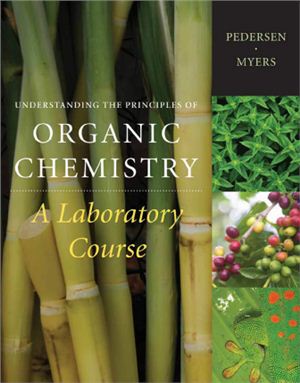Brooks/Cole Cengage Leraing. 2011. 437 p.
Class-tested by thousands of students and using simple equipment and green chemistry ideas, UNDERSTANDING THE PRINCIPLES OF ORGANIC CHEMISTRY: A LABORATORY COURSE includes 36 experiments that introduce traditional, as well as recently developed synthetic methods. Offering up-to-date and novel experiments not found in other lab manuals, this innovative book focuses on safety, gives students practice in the basic techniques used in the organic lab, and includes microscale experiments, many drawn from the recent literature. An Online Instructor's Manual available on the book's instructor's companion website includes helpful information, including instructors' notes, pre-lab meeting notes, experiment completion times, answers to end-of-experiment questions, video clips of techniques, and more.
Contents
Part I Theory and Techniques
Safety in the Chemistry Laboratory
The Laboratory Notebook and the Laboratory Period
Where to Find It: Searching the Literature
Things You Need to Know Before You Begin
Properties of Organic Molecules
Characteristic Physical Properties of Pure Compounds
Isolation and Purification of Compounds
Structure Determination
Running a Synthetic Reaction
Part II Experiments
Calibrating a Pasteur Pipette
Investigating Solubility and Acid-Base Reactions
Mixed Melting Points
Whittling Down the Possibilities: Identifying an Unknown Using Molecular Dipole Moment, Solubility, Density, and Boiling Point Data
Recrystallization and Melting Points: Recrystallization of Adipic and Salicylic Acids
Recrystallization and Melting Points: Recrystallization of an Unknown Solid and Decolorization of Brown Sugar
Thin Layer Chromatography (TLC)
Identification of an Adulterated Herb or Spice by Thin Layer Chromatography (TLC)
What Do You Take for Pain?
Nucleophilic Substitution Reactions of Alkyl Halides
Isolation of Trimyristin from Nutmeg
The MagtrieveTM Oxidation of 4-Chlorobenzyl Alcohol, A Solvent-Free Reaction
The Sodium Borohydride Reduction of Benzil and Benzoin
The Grignard Reaction: The Preparation of 1,1-Diphenylethanol
The Asymmetric Dihydroxylation of trans-Stilbene
Some Chemistry of a-Pinene Oxide
A Dehydrogenation/Hydrogenation Reaction
The Friedel-Crafts Reaction
Microwave Heating of Organic Compounds
The Reaction of 1,1-Diphenylethanol on Clay in the Presence of Microwave Radiation
The Wittig Reaction
The Suzuki Reaction
The Crossed-Aldol Condensation
Identifying the Structure of an Aldehyde by Qualitative Analysis
The Benzoin Reaction
The Diels-Alder Reaction
Synthesis of an a,b-Unsaturated Carboxylic Acid Derivative
The Reaction of 2-Acetylphenyl Benzoate with Potassium Hydroxide. Part I
The Reaction of 2-Acetylphenyl Benzoate with Potassium Hydroxide. Part II
Synthesis of 1,2,3,4-Tetrahydro-b-Carboline
Base-Catalyzed Hydrolysis of Nicotinonitrile Using an Anion-Exchange Resin
Reactions of Salicylamide
The Hunsdiecker Reaction
The Investigation of the Mechanism of a Reaction
Monoterpenes and the Ritter Reaction
Chemoselectivity in Transfer-Hydrogenation Reactions
Class-tested by thousands of students and using simple equipment and green chemistry ideas, UNDERSTANDING THE PRINCIPLES OF ORGANIC CHEMISTRY: A LABORATORY COURSE includes 36 experiments that introduce traditional, as well as recently developed synthetic methods. Offering up-to-date and novel experiments not found in other lab manuals, this innovative book focuses on safety, gives students practice in the basic techniques used in the organic lab, and includes microscale experiments, many drawn from the recent literature. An Online Instructor's Manual available on the book's instructor's companion website includes helpful information, including instructors' notes, pre-lab meeting notes, experiment completion times, answers to end-of-experiment questions, video clips of techniques, and more.
Contents
Part I Theory and Techniques
Safety in the Chemistry Laboratory
The Laboratory Notebook and the Laboratory Period
Where to Find It: Searching the Literature
Things You Need to Know Before You Begin
Properties of Organic Molecules
Characteristic Physical Properties of Pure Compounds
Isolation and Purification of Compounds
Structure Determination
Running a Synthetic Reaction
Part II Experiments
Calibrating a Pasteur Pipette
Investigating Solubility and Acid-Base Reactions
Mixed Melting Points
Whittling Down the Possibilities: Identifying an Unknown Using Molecular Dipole Moment, Solubility, Density, and Boiling Point Data
Recrystallization and Melting Points: Recrystallization of Adipic and Salicylic Acids
Recrystallization and Melting Points: Recrystallization of an Unknown Solid and Decolorization of Brown Sugar
Thin Layer Chromatography (TLC)
Identification of an Adulterated Herb or Spice by Thin Layer Chromatography (TLC)
What Do You Take for Pain?
Nucleophilic Substitution Reactions of Alkyl Halides
Isolation of Trimyristin from Nutmeg
The MagtrieveTM Oxidation of 4-Chlorobenzyl Alcohol, A Solvent-Free Reaction
The Sodium Borohydride Reduction of Benzil and Benzoin
The Grignard Reaction: The Preparation of 1,1-Diphenylethanol
The Asymmetric Dihydroxylation of trans-Stilbene
Some Chemistry of a-Pinene Oxide
A Dehydrogenation/Hydrogenation Reaction
The Friedel-Crafts Reaction
Microwave Heating of Organic Compounds
The Reaction of 1,1-Diphenylethanol on Clay in the Presence of Microwave Radiation
The Wittig Reaction
The Suzuki Reaction
The Crossed-Aldol Condensation
Identifying the Structure of an Aldehyde by Qualitative Analysis
The Benzoin Reaction
The Diels-Alder Reaction
Synthesis of an a,b-Unsaturated Carboxylic Acid Derivative
The Reaction of 2-Acetylphenyl Benzoate with Potassium Hydroxide. Part I
The Reaction of 2-Acetylphenyl Benzoate with Potassium Hydroxide. Part II
Synthesis of 1,2,3,4-Tetrahydro-b-Carboline
Base-Catalyzed Hydrolysis of Nicotinonitrile Using an Anion-Exchange Resin
Reactions of Salicylamide
The Hunsdiecker Reaction
The Investigation of the Mechanism of a Reaction
Monoterpenes and the Ritter Reaction
Chemoselectivity in Transfer-Hydrogenation Reactions

